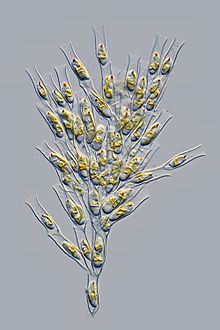| Dinobryon | |
|---|---|

| |
| Dinobryon divergens | |
| Scientific classification | |
| Domain: | Eukaryota |
| Clade: | Diaphoretickes |
| Clade: | SAR |
| Clade: | Stramenopiles |
| Phylum: | Gyrista |
| Subphylum: | Ochrophytina |
| Class: | Chrysophyceae |
| Order: | Chromulinales |
| Family: | Dinobryaceae |
| Genus: | Dinobryon Ehrenb.[1] |
Dinobryon is a type of microscopic algae. It is one of the 22 genera in the family Dinobryaceae. Dinobryon are mixotrophs,[2] capable of obtaining energy and carbon through photosynthesis and phagotrophy of bacteria. The genus comprises at least 37 described species.[3] The best-known species are D. cylindricum and D. divergens, which come to the attention of humans annually due to transient blooms in the photic zone of temperate lakes and ponds. Such blooms may produce volatile organic compounds (VOCs) that produce odors and affect water quality.[4]
Dinobryon can exist as free-living, solitary cells or in branching colonies.
- ^ Guiry, M.D. & Guiry, G.M. 2013. AlgaeBase. World-wide electronic publication, National University of Ireland, Galway. http://www.algaebase.org; searched on 4 March 2013
- ^ Caron, David A.; Sanders, Robert W.; Lim, Ee Lin; Marrasé, Celia; Amaral, Linda A.; Whitney, Sheri; Aoki, Rika B.; Porters, Karen G. (1993). "Light-dependent phagotrophy in the freshwater mixotrophic chrysophyte Dinobryon cylindricum". Microbial Ecology. 25 (1): 93–111. doi:10.1007/BF00182132. PMID 24189708.
- ^ "WoRMS – World Register of Marine Species – Dinobryon Ehrenberg, 1834". marinespecies.org. Retrieved 11 March 2019.
- ^ "The influence of growth conditions on odor-compound production by two chrysophytes and two cyanobacteria". Water Science and Technology. 31 (11). 1995. doi:10.1016/0273-1223(95)00472-y.